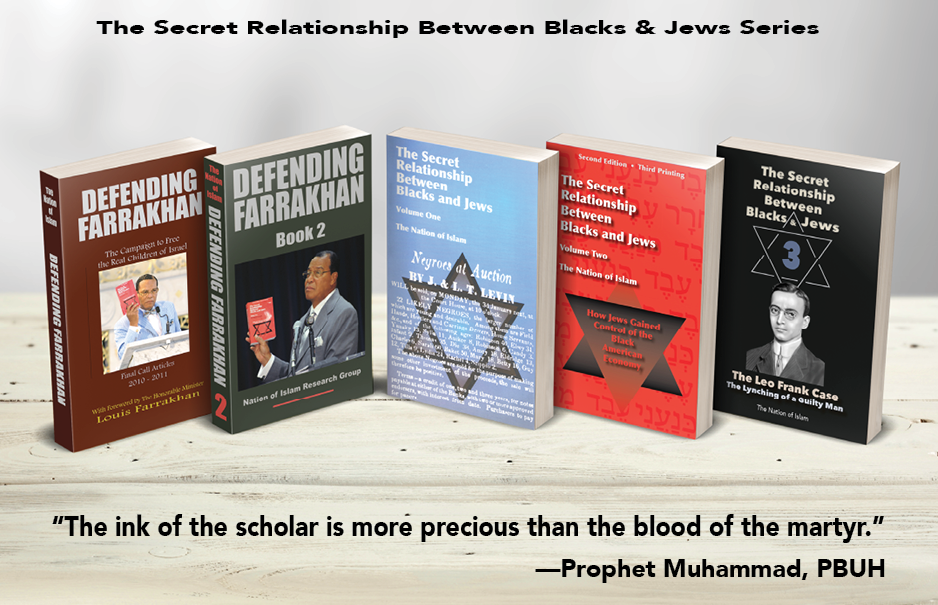The Two Messiahs
By Brother Jackie Muhammad
For thousands of years the world of religion and some in government have been awaiting the arrival of the Messiah, one on whose shoulders a new government would be placed and through whom a new world order would emerge. The person identified as the Messiah is the most important person in Islam, Christianity, and Judaism.
Mystery has surrounded both the identity and the arrival of the Messiah. Believing that a Messiah was on the horizon to replace him, King Herod, the “king of the Jews,” under the authority of Rome, was so protective of his throne that he killed his own son because he viewed his offspring as a threat to his kingship. Referring to Herod’s Jewishness, the Roman emperor Augustus reportedly joked, “It was safer to be Herod’s swine than his son” (Macrobius, Saturnalia, 2:4:11). Herod then issued orders that all first-born male children of Bethlehem were to be killed as well. His main objective was to kill the Messiah, thereby extending his own longevity as ruler.
Two thousand years later, the Government of the United States of America, along with the leadership of the Jewish community, has been obsessed with the advent of a modern-day Messiah, someone who would end the world of White Supremacy and global Jewish hegemony. The Jews, represented by the ADL, entered into a pact with the U.S. Government, represented by the FBI under the leadership of J. Edgar Hoover and later Director William Webster, to identify and destroy the one who they feared would emerge as the Black Messiah. (The Jewish Onslaught; The Secret Relationship Between Blacks and Jews, vol. 2; <https://www.noi.org/cointelpro/>)
Definition of Messiah
What does the word Messiah mean? Who is the Messiah? Would there be one Messiah or multiple Messiahs? Where will he (they) come from? What is his (their) relationship to God? What would he (they) look like? Why should the world both rejoice and fear his (their) presence?
The word Messiah means one anointed to lead, a savior or liberator of a group who has suffered oppression; a person considered a king and a high priest. The English word Messiah is a noun derived from the Hebrew word mashach, which means “to smear with oil, anoint.” In the Abrahamic religious tradition some scriptural interpretations speak of a king who is to be sent by God, and accompanied by a high priest who is also considered a part of the messiahship.
In both the early Christian and Jewish traditions, the concept of multiple messiahs was fairly common. The Old Testament speaks of two Messiahs. In both the Book of Isaiah (chapter 53) and the Book of Zechariah (4:4) two “anointed ones” are mentioned. Zechariah foretold of a man called “the Branch.” The branch was identified as one who would sit on the throne. But seated next to the kingly “Branch” would be an anointed priest. The two anointed Messiahs would stand before “the Lord of the whole earth.” In Zechariah’s vision, the “two olive branches” stand before the Menorah, the seven- branched oil lamp that symbolized God’s spirit and presence. Each “branch” represents an aspect of two separate individuals.
In the pre-Christian pseudepigrapha (religious writings whose authorship is unknown) the Testaments of the Twelve Patriarchs, we learn that “the Lord will raise up from Levi someone as high priest and from Judah someone as king” (Testament of Simon 7.2).
Further, according to a June 3, 2015, article in the Huffington Post titled “Waiting for the Messiahs? One, Two or Three?” written by James D. Tabor, the author questions the validity of just one Messiah to come. In his book The Jesus Dynasty, Tabor examines the concept of the two Messiahs. The topic became headline news in US News and World Report, as well as on ABC’s Good Morning America, 20/20, and Nightline.
As time progressed and as Judaism underwent a transition away from the purity of the teachings of Abraham and Moses, that tradition and the concept of multiple messiahs underwent a transition also. Aspects of that transition can be traced to the leadership of Ezra, a priest and a scribe who was placed in charge of the Jewish colony that had been under Babylonian captivity from approximately 597 BCE to 539 BCE. When the Babylonians were defeated by the Persians, the king of Persia, Cyrus the Great, allowed the Jews to return to Judea. The Persian king appointed Ezra as the new leader of the Jews. What is a factor, however, is the impact of Persian monotheism on Ezra and the Jews who had been held in captivity in Babylon. After that period a new form of Judaism emerged. Eschewing Allah’s warnings in the Quran not to change the religion or modify the scriptures, the Jews did both. They integrated aspects of the Babylonian and Persian religions into their nascent practice of Judaism. Hence, the period of Babylonian captivity becomes a pivotal point in the history of messianic interpretation.
Not only did the Jews write a new scripture with their own hands, the Talmud, they also modified the Old and New Testaments to conform to their own religio-political narrative. An aspect of that narrative included the concept of a single messiah, instead of multiple messiahs. According to the Holy Quran (9:30), for example, the Jews revered Ezra so much that they called him “The son of God.” Therefore, for some Jews, Ezra had reached the status in Judaism that Jesus had reached in Christianity.
Prior to their captivity in Babylon these half-hearted followers of Moses did not practice the teachings of Moses exclusively; they were not strict monotheists: they were practicing a form of monotheism called monolatrism, the worship of mini-gods in addition to a Supreme Being.
One group of believers who faithfully followed the teaching of Moses was called the Essenes. The Essenes were distinct from the Jews called the Sadducees and the Pharisees. (See The Meaning of the Dead Sea Scrolls.) The Essenes were highly influenced by the African (Egyptian) adherents of the monotheistic followers of Aton (The Mystery of the Copper Scroll of Qumran), and they were abstemious, pious, and studious. They considered the Sadducees and the Pharisees to be corrupt and sinful followers of Moses, and, quite frankly, out of their (the Essenes’) league; indeed, they were enemies. The Essenes produced the purist Biblical texts ever used for Biblical translations. The text used by the Sadducees and the Pharisees was the Masoretic Text. Our King James Version of the Bible is the byproduct of the Masoretic translation. The purer, more precise, translation of the Essene documents, known as the Qumran Scrolls, predates the Masoretic text by almost 1000 years. These were original translations and original documents written by the Essenes themselves. Therefore, many scholars consider the Masoretic text to have been corrupted (redacted), and in several passages it does not conform to the purer texts of the Qumran Scrolls.
Another distinction between the Essenes and the Sadducees/Pharisees was the latter’s support and justification of slavery (as evidenced in both the Torah and the Talmud). The Bible and the Talmud were referenced by the Jews as a justification for their control of the slave industry.
However, the more significant aspect of the distinctions between the groups has little to do with ethnicity or how they viewed each other’s religiosity. One of the main differences between the two groups has to do with how they viewed the coming Messiah. The Masoretic scholars changed the messiahship from representing two individuals to being a single Messiah.
Aaron: The First Messiah
The Essenes believed in a Messiah of Aaron and a Messiah of Israel, in addition to a Teacher of Righteousness. All three were to make a joint appearance at the end of the rule of the enemies of God. One Messiah was to be a high priest and the other was to be a king. Ironically, according to Philo of Alexandria, also known as Philo Judaeus, the first man to be anointed as the Messiah was Aaron, the brother of Moses. Philo was a Jewish priest and a proponent of Aristotle and Plato. He bears witness to the Teachings of the Nation of Islam that speak of Christianity being a man-made religion, not of divine origin. Philo was one of the key figures who merged Hellenism with Judaism and created a new religion—Christianity. Accordingly, the biblical scholars who wrote The Interpreter’s One-Volume Commentary on the Bible concluded that Philo’s goal was to make Judaism acceptable to the Greeks. However, a portion of the Jewish community never accepted this. This position is exemplified in the positions adopted by the Jews under the rule of the Maccabees.
The Maccabees were a priestly family that led a revolt against Hellenism (Hellenic influence) in 168 B.C. They founded the Hasmonean dynasty, which rebelled against the Greeks and Hellenized Jews, reasserted Judaism, and reduced the influence of Hellenism and Hellenistic Judaism throughout Judea. These actions also led to a split between the rank-and-file Jews and the orthodox or traditionalist Jews on the one hand and the Hellenized Jews on the other. The Hellenized Jews sought the favor of their Greek overlords; the religious Jews never fully accepted the rule of the Hellenized Jews because the role of a spiritual Messiah was absent: they emphasized only the role of a political leader, not that of a religious Messiah.
With the emergence of Antiochus IV Epiphanes, the newly elected Greek ruler, the persecution of the Jews increased. With this increase in Jewish persecution, a division among the Jews was further exacerbated. The rank and file and the orthodox Jews were expecting the return of two Messiahs; the Maccabees did not. The Maccabees sought political accommodation with their oppressors; the other Jews wanted complete freedom from the Greeks.
According to Dr. Leila Leah Bronner, noted Jewish author, professor, and activist (“The Jewish Messiah: A Historical Perspective”), the Jews became wary of the idea that God was going to send a savior to redeem them. The Mishna, the Midrash, and the Talmud all downplay the role of the Messiah. Further, there is no mention of the Messiah after the failure of the Bar Kochba revolt (the second Jewish revolt against the Romans in 132 CE). The rabbis place emphasis on a “Messianic Age” and a “Messianic people” instead of a Messiah per se. The rabbinic Jewish leaders began to rely less on a Supreme Being and more on the supremacy of their own being. If God abandoned them, they were going to abandon Him.
The Concept of the Messiah and the Growth of Zionism
With the emergence of the period known as the European Enlightenment in the 18th century, Jewish thinkers stressed rational thinking and de-emphasized a belief in the supernatural aspects of the Old Testament. This led to the evolution of the Reform Judaism movement, and a move away from Orthodox Judaism. With this came the abandonment of the concept of a personal Messiah and the further adoption of a belief in a messianic people. A by-product of this movement was the emergence of modern Zionism.
The Dual Personalities of Melchizedek
Melchizedek is viewed as one of the most mysterious figures in the Old Testament. He is also viewed as the model upon which the Messiah is to be based. Melchizedek embodies a dual personage: a king and a priest. Melchizedek was the King of Salem and the “Priest of the Most High God.” Like Elijah, Melchizedek never dies and he prefigures the Christ figure of the New Testament. Melchizedek is a compound noun, combining Malachi and Zadok, or Elijah and Aaron. Malachi was a prophet and “God’s Messenger,” while Zadok, was the chief priest of Judah and a descendant of the son of Aaron. In Ugaritic mythology Salem, or Salim, is said to have been a god identified with the evening star. In the Holy Qur’an (Surah 53) we see a reappearance of that “star,” Al Najm, in its association with the cluster of stars known as the Pleiades.
God Empowers the Messiahs
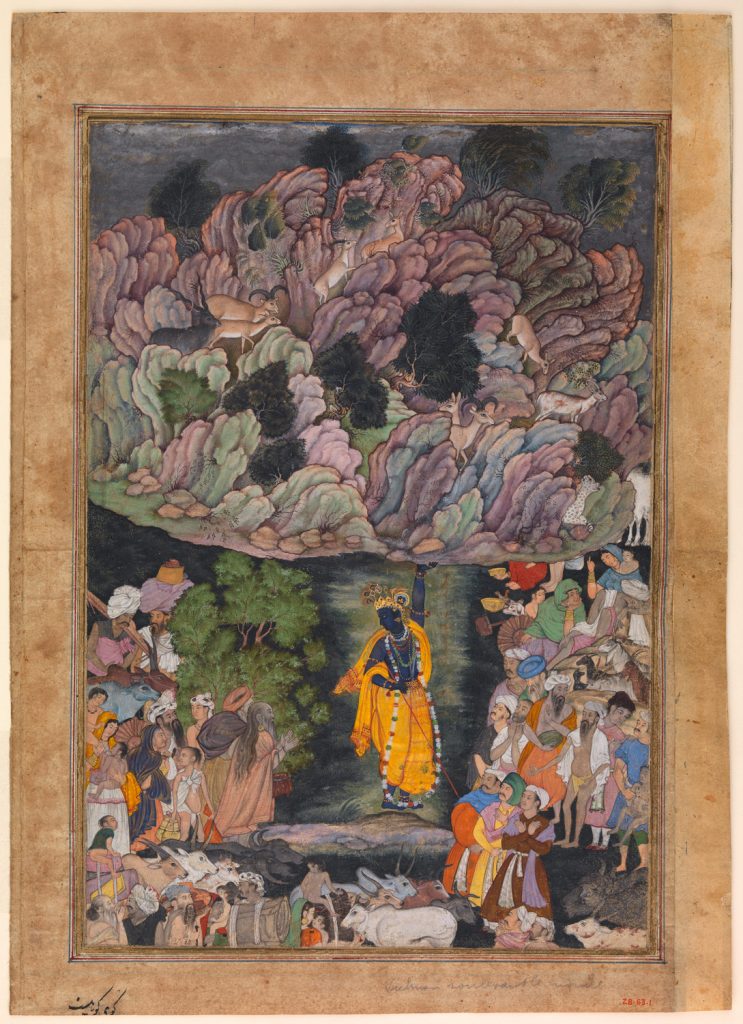
What is the job of the Messiah? Where will he come from? What will he look like? Is he White, Black, Asian? According to a compilation of the character personality traits identified in the Scriptures, the Messiah will be a man of color. Daniel, Ezekiel, and John the Revelator describe him as a man with wooly (kinky) hair, an original (Black) man whose skin is the color of brass burned in an oven (black).
Daniel, Ezekiel, and John the Revelator also used the terms “Son of man,” “son of man,” and “one like a son of man” to depict the Christ figure. What is interesting is that each term has a different, yet similar, meaning, but they are also used interchangeably. One is a proper noun, one is a common noun, and one is indefinite; at the same time, they are all used to describe dual identities. The terms “son of man” and “one like a son of man” are subordinate to the “Son of man”; in addition, the term “Son of God” is used co-equally with the term “Son of Man” by some of the writers of the New Testament. In the English language they could be considered synonyms. Synonyms are words that may be spelled and pronounced differently, but mean exactly the same thing. The words “urban” and “inner city,” for example, are used as synonyms for “Black.”
In Daniel 7:13-14, the “Ancient of Days” (God) gives dominion over the earth to “one like the son of man,” and this person is also given control of the “Wheel” (the ultimate weapon of mass destruction), as described in the Book of Ezekiel, to destroy the enemies of God, and bring about the final judgment of the world.
Prophet Muhammad on the Messiah
According to the Book of Malachi the job of the Messiah is to pave the way for the coming of God. He is to teach the despised and rejected of the Western world (the American Black man and woman) the true knowledge of God. The despised and rejected, according to the Holy Qur’an (Surah 62), are akin to the illiterates who had been without the knowledge of God. Prophet Muhammad (PBUH) puts it this way: “He it is Who raised among the illiterates a Messenger from among themselves, who recites to them His messages and purifies them, and teaches them the Book and the Wisdom—although they were before certainly in manifest error—And others from among them who have not yet joined them. And He is the Mighty, the Wise (H.Q. 62:2-3). Hence, the Messiah is to come from a community of people who are despised, rejected, and illiterate.
Two key figures in the Book of Malachi are Elijah and Elias. Some scholars view Elijah and Elias metaphorically and symbolically as one, and they equate the reemergence of Elijah with the return of Elijah and Elias.
Malachi says the long-awaited One is to come from the East, which, according to the Book of Habakkuk, is where God Himself would reside. He is to come to America, where the dead (“the carcass”) are. Daniel said he is to be a man of color. John the Revelator said the same. Ezekiel said the same thing, and he referred to the Messiah as “son of dust” (Ezekiel 3).
Prophet Muhammad said that “[e]ven if faith were near the Pleiades,” a non-Arab from among the illiterates would find it. (See the exegesis of Surah 62, The Congregation.) Further, according to a Hadith, the Messiah will appear at a time when the Arabs will appear to have the letter of the law and not the spirit of the law. In Surah 53, The Star is associated with the Pleiades, which is a cluster of 7 stars in the constellation Taurus the Bull. Aldebaran, considered the Eye of the Bull, is the brightest star in the constellation Taurus and is often used as a guidepost by navigators and astronomers. Al Dabaran is Arabic for “The Follower.” Taurus, by the way, is the astrological sign of the Honorable Minister Louis Farrakhan.
The Pleiades, or the Seven Sisters, are sometimes associated with the cluster of stars known as the Little Dipper. The North Star lies at the end of the handle of the Little Dipper. When the slaves were trying to find their way to freedom to the North (Canada), they just had to follow the North Star. However, in order to find the North Star one had to locate the Big Dipper, an asterism of the 7 brightest stars of the constellation Ursa Major that would point the wayfarer to the Little Dipper, or the North, then to eventual freedom. Thus, to find the North Star, one would first have to find the Big Dipper. The Big Dipper would then point you to the Little Dipper.
The Big Dipper was originally sighted in Africa, where it is seen as a drinking ladle and known as the Drinking Gourd; hence, the famous Underground Railroad code song “Follow the Drinking Gourd” exhorted Blacks seeking to escape enslavement to follow a northerly course. The following is a reference to a scene in the movie Django, where a White dentist shows up to free the enslaved Django. In the process he gives the other slaves a way out of their enslavement by following the North Star to freedom.
“As to you poor devil, so as I see it. When it comes to the subject of what to do next you, gentlemen, have two choices. One: once I am gone, you can lift that beast [horse] off the remaining speck [slave dealer], then carry him to the nearest town. Which would be 37 miles back the way you came. Or two: you can unshackle yourselves, take that rifle, put a bullet in his head, bury the two of them deep, then make your way to a more enlightened area of this country. Choice is yours. Oh, and on the off chance there are any astronomy aficionados amongst you, the North Star is that one [he points them to that direction]. Ta-ta.”
I believe the two constellations are equivalent to the two Messiahs. I further believe that Allah is using the two constellations as metaphors for two human beings—the dual Messiahs, the two Dippers, the two Sons of Man (or ones like the son of man in the Book of Daniel): two men who will lead the people to their ultimate freedom. These two men are Black men who have been taught and trained to serve as Allah’s representatives before the people. By the process of elimination, there are only two human beings that these metaphors, these synonyms, apply to: they are the Honorable Elijah Muhammad and the Honorable Minister Louis Farrakhan. It is my opinion that the high priest is the Honorable Minister Louis Farrakhan and the worldly king is the Honorable Elijah Muhammad, and in many ways their roles are interchangeable.
In the Book of Daniel in the Old Testament, the Son of man, the Christ, the Messiah, has an encounter with the Supreme Being, the Lord of the Worlds. God, while on His throne on what some refer to as a UFO or Ezekiel’s Wheel, is passing judgment on the nations of the Earth. After passing judgment He then cedes his power and authority to his Son, His Messiah. Global leadership is now in the hands of His Anointed ones.
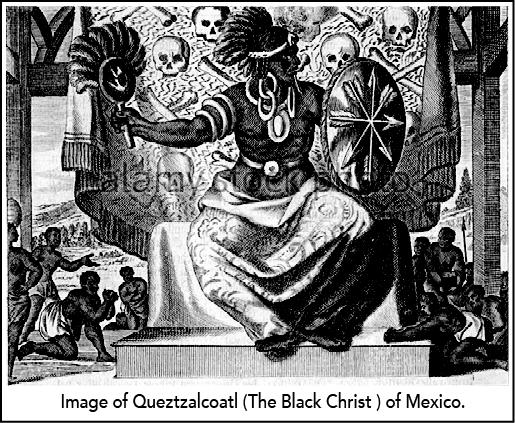
Job Description of The Messiahs
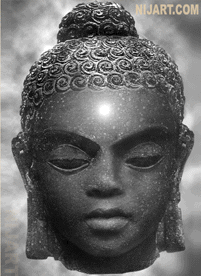
If we were to create a fictional Job Description for the Messiahs, the job description would specify the following criteria, based on a compilation of requirements culled from the Scriptures:
- The Messiahs will come from a community of Black people who have suffered oppression (slavery, sharecropping, Jim Crow apartheid) at the hands of a strange people, in a land not theirs (America) for over 400 years.
- They must be Black Americans living in the West.
- The pigmentation of the epidermis would have to be of a dark hue (as detailed in the Books of Revelation, Ezekiel, and Daniel). However, the Black skin of the Messiahs is not unique. The Messiah figures in Buddhism, Hinduism (Krishna, the Black Hindu Christ, for example); Osiris, the Christ of the Ancient Egyptians; as well as Quetzalcoatl, the Mexican Messiah—all have been depicted as Black men imbued with Africoid features. The first physical depiction of Jesus was that of a Black child with a Black mother, the Black Madonna and Child.
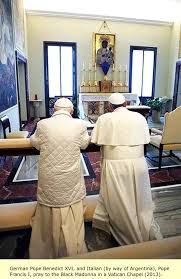
Pope praying to the Black Madonna. These pictures and statues are still prominently featured in many Eastern European churches today, as well as in the private prayer room of the Pope of Rome. Therefore, the Blackness of Farrakhan and Muhammad is totally in line with the Christ figures throughout history.
- The Messiah (Son of Man) must be able to drive a UFO, or what the Jewish scholars call a Merkabah, and use the Wheel to destroy the enemies of God.
- The Messiahs will make their appearance when the Arabs have the Letter of the Law but not the Spirit of the Law.
- They will be hated by the chief enemies of God (the Jewish leadership/Synagogue of Satan).
- They will perform miracles, such as the Million Man March, Dope Busters, and Justice Or Else Movement.
- They will teach the illiterates a knowledge of themselves and the Wisdom of the Scriptures.
- Must come from a family that is as old as the Earth.
- Must exhibit sublime moral and ethical characteristics.
- Must be able to exhibit justice to both Black and White people.
- Must be a musician, able to be in tune and in rhythm with all of humanity.
- Must be a Spiritual Genius.
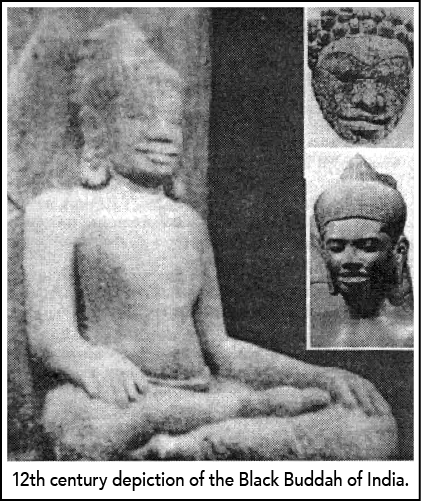
The Messiahs are not to be played with or disrespected. In the paraphrased version of the Living Bible (Ezekiel 33:30) we learn:
Son of dust, your people are whispering behind your back. They talk about you in their houses and whisper about you at the doors, saying, “Come on, let’s have some fun! Let’s go hear him tell us what the Lord is saying.” So they come as though they are sincere and sit before you listening. But they have no intention of doing what you tell them to; they talk very sweetly about loving the Lord, but with their hearts they are loving their money. You are very entertaining to them, like someone who sings lovely songs with a beautiful voice or plays well on an instrument. They hear what you say but don’t pay any attention to it! But when all these terrible things happen to them—as they will—then they will know a prophet has been among them.
If we accept the above as the characteristics of the Messiahs, then the above can only apply to two men— Elijah Muhammad and Louis Farrakhan. No one else need apply.
By Brother Jackie Muhammad. He can be reached by email at jacrb519 [at] aol.com.


